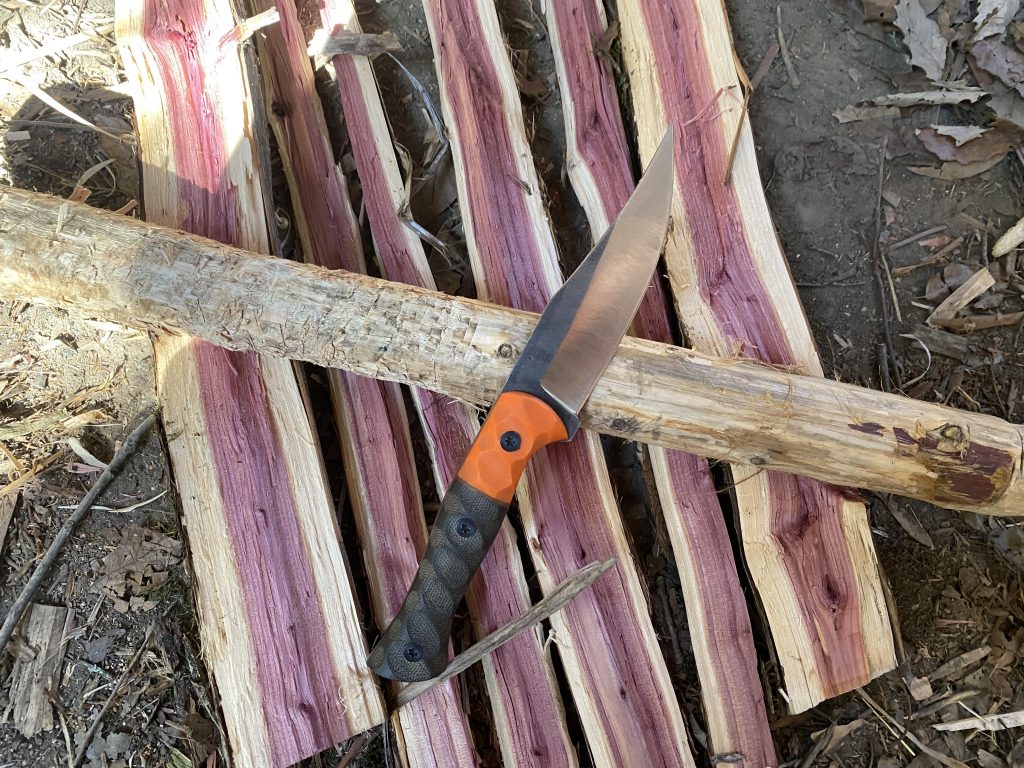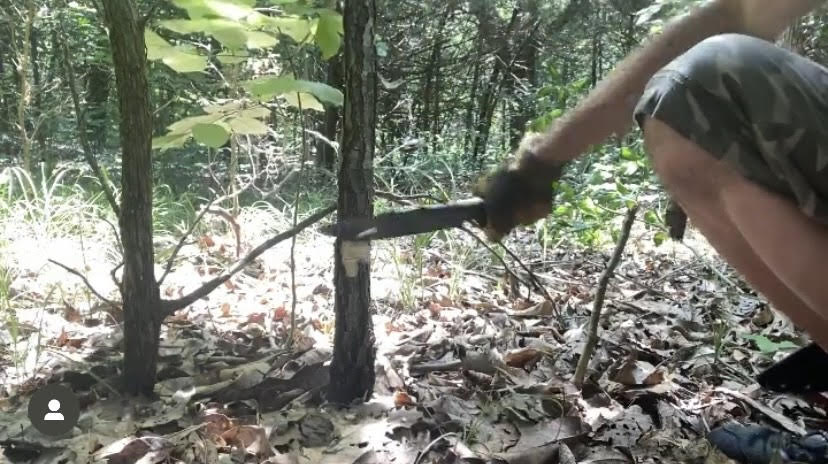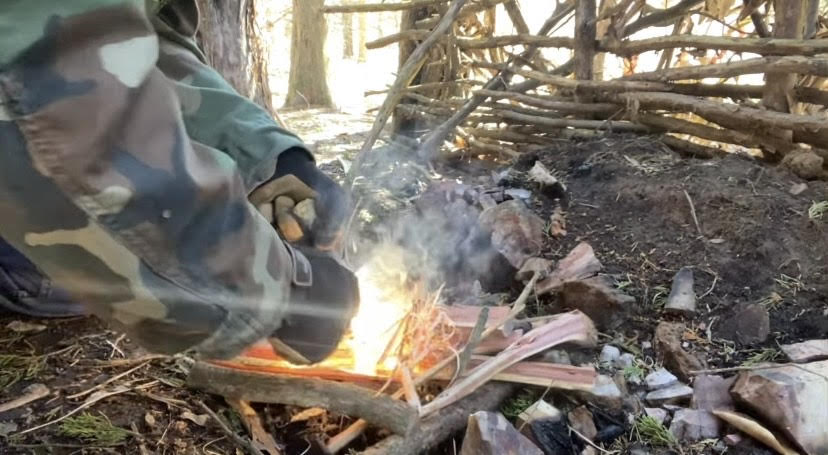By Gabriel- The Last Huntsman
As with many of us in the Beartaria community, we have found the mundane existence of modern Babylon completely unappealing, ungodly, and unfulfilling. As a result, many of us seek to make our way, either by downsizing our footprint in the modern digital world, homesteading our sustenance, or becoming producers. For some of us, however, that also means getting out into the wilderness; far away from civilization, we test ourselves and our bodies to become more like our ancestors of old, becoming non-domesticated humans.
In this article series, I will detail at least one part of the wilderness- a popular term coined as bushcraft. Bushcraft seemingly has taken many different names and forms.
For me, it’s practicing basic wood skills such as shelter craft, fire craft, knife skills, axe skills, and other tools, and can even have some hunting or tactical applications.
Though you can write a whole book on bushcraft, as many already have, we’re just going to get into some knife basics for this article.
Choosing Your Knife
Knives are mankind’s first tool; they are essential for basic tasks, whether processing your food, wood processing, cutting cordage, etc. In addition, knives can be used in a myriad of practical tasks and defensive means. While having a flimsy folding knife can be ok for opening boxes or backyard/vehicle camping, bushcrafting skills require having a solid and reliable fixed-blade knife, ideally full tang, for practical tasks.
You will have to determine if a smaller knife or a larger knife would better suit your purposes. A saying often goes, however, that you can do small tasks with a big knife if you have to, but you can’t do big tasks with a small knife, but having a smaller blade is less weight and easier to conceal. That’s just food for thought. Another consideration is steel choice; I will simplify carbon steel or stainless steel. Knife Nerds is an excellent resource to dabble into all things knife steel. Carbon steel, while generally tougher than stainless steel, can be prone to rust. So if you’re in a coastal environment, it can be hard to maintain. Stainless steel is more rust-resistant and can have better edge-holding capabilities. However, it can be more prone to snapping or chipping during extreme use.


Knife Skills
Using your knife to split wood is known as batoning. This is done by utilizing your knife as a wedge while you use another log (baton) as a mallet to beat the spine of your knife blade through the log. This can be a rather rigorous task on your knife. However, it is sometimes needed to make wood burnable when conditions are wet or when it’s hard to stabilize a log and safely use an axe. In many cases, the wood logs could be wet; however, the wood on the inside will be dryer and more suitable for fire craft. Splitting wood is necessary for ease of burning to cook, keep warm, and many other things.


Making feather sticks with a knife is another handy bushcrafting knife skill. It is done by finely slicing small curls of wood into a bundle. This bundle is perfect for fire tinder. While most small sticks, twigs, and other tinder may be too big or have too much moisture to catch a spark well, the feather sticks can be from a freshly split log that you just have batoned, which should be dryer. Making feather sticks takes time to master, learning what knives work best and what wood works best. The finer and thinner your wood curls are, the better; they will catch a spark or flame easier to start your fire.


Chopping is another handy knife skill to practice. I’m sure many will ask why you would use a knife to chop when you can use an axe. Well, for one, it’s more likely to have a knife on your person than an axe. If you’re hunting, scouting, or hiking, having a solid knife is lighter than packing a knife and an axe. Finally, it can be safer, as having an axe in full swing can be more likely to miss or over-swing. Having a medium to larger knife size will obviously help with the performance of this task. Good ergonomics will help the knife maintain in hand and absorb shock during chopping tasks.


Striking a ferro rod (ferrocerium rod) is a skill that can help you get a fire going in your wilderness adventures. Firstly a ferro rod is a metal rod that will produce sparks when struck with a flat edge and can last thousands of strikes. So why use it over a lighter? Lighters can be finicky at best; they can get too cold, wet, or drain themselves of fluid. That is a big no-no, mainly when you’re depending on it.
So simply put, Ferro rods are just a survivalist/bushcrafter’s go-to fire-starting tool. Ideally, your knife will have a 90-degree spine on the back edge of the blade. This sharp, flat edge can strike and scrape the ferro rod. However, not all knives have a sharp spine, so having a small scraper or a spare knife may be necessary. In a worst-case scenario, you can use the edge of your knife; however, this is not recommended as it will damage your edge. When using the Ferro rod with your blade, you want to ensure your rod is as close to your tinder bundle (feather sticks) as possible. This will maximize the amount of sparks and heat transferred into those fine wood curls to get a fire going.


Notches are another bushcrafting knife skill that is good to learn. It is essentially cutting a notch in various shapes to allow cordage to be held in place for constructing many things in the wilderness. Notches can be used to build tent stakes, fire spits, shelters, and even wild game traps. Notches can be carved directly using the knife or with a knife and baton. Though there are several notches, the few fundamental ones are the square notch, v notch, and stake notch. They may seem self-explanatory; however, carving these can take a measure of skill with your knife. Square notches can be done by simply partially cross-batoning your knife into the wood, then doing so again, a short distance from the first, and twisting your knife- this will pop the excess wood. Stake Notches are achieved by partially cross-batoning and carving the extra wood with your knife toward your baton mark. V notches are done by cutting a ‘V-shaped groove into the wood.

Then, one of the oldest knife skills is probably out there, processing animals or vegetation for food. People have been using knives to kill and butcher their livestock and wild game or cut up their humble veggies since humanity’s beginning. As we return to our roots, having these knife skills can make things much more manageable and save you money.


Knives will perform numerous tasks, better or worse, based on their grind, edge geometry, and thickness. That said, I have found that a full flat grind (shown on the knives pictured above) is ideal for food prep and butchering, though a high saber grind works well too.
As I’ve stated, knives are one of mankind’s primary tools. We will always have a place to use a blade, especially as we separate ourselves from this fruitless modern world. These are just a few simple knife skills necessary for bushcrafting and wilderness adventures. The easy way to practice and master knife skills is to get out there and try to have fun. As you enjoy yourself, you’ll find ways to make things happen. Always check out my content on my Youtube channel, Beartaria Times app, and Instagram at The Last Huntsman. Feel free to follow up and message me with any questions. Finally, be prepared both physically and spiritually. God bless and carry on.




